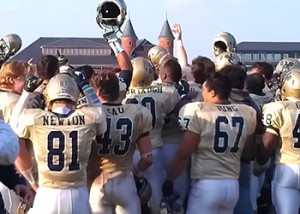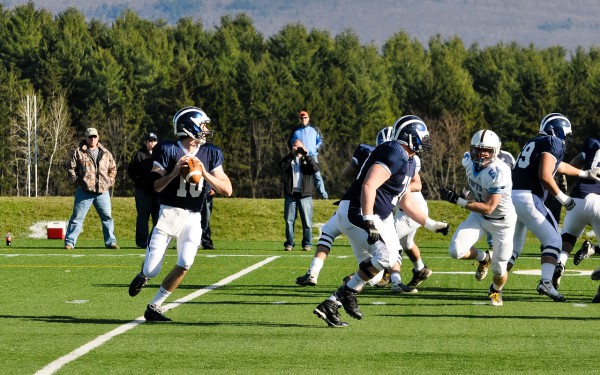
A year ago Trinity captured the NESCAC title on the road at Wesleyan. This year the Cardinals attempt to do the reverse.
A year ago, 6-1 Middlebury hosted 0-7 Tufts needing a win and a Wesleyan victory at home against Trinity to secure a share of the NESCAC title. Today, the situation is eerily similar, if the details have been revised. The 6-1 Panthers kick off against Tufts (0-7 and losers of 30 straight games) at 12:30 today, 30 minutes after action gets underway in Hartford, where Middlebury (and Amherst) fans hope that Trinity (5-2) can extend its home-winning streak to 51 games and knock off unbeaten Wesleyan. A Middlebury victory and a Wesleyan loss would give the Panthers a share of the NESCAC title—likely split three ways if Amherst (6-1) can beat rival Williams (2-5) in Williamstown. There will be a fair number of people split-screening today’s games, with multiple rooting interests. (Perhaps less significant in the final standings, but no less interesting: if Colby beats Bowdoin and Trinity loses, Colby and Trinity will each finish the season 5-3, having beaten and lost to the same teams.)
Our Guide to the Games
The NESCAC, Middlebury aside, is not a passing league. Teams win games by establishing the run early and stopping the run on defense. Expect both Trinity and Wesleyan to pound the ball early, in a matchup of truly dynamic runners in both backfields. LaDarius Drew and Kyle Gibson have been the more prolific pair this year, but Bunker and Crick have history and home-field advantage on their side. 50 straight wins at home attests to the Bantams’ dominance at Jessee/Miller Field, where Trinity has been an even better team running the football this season, averaging 239.3 yards per game. Furthermore, today’s finale is Homecoming for Trinity, creating an atmosphere unlike any other in the NESCAC with a crowd likely to exceed 7,000 people.
Just over 100 miles northeast, Middlebury and Tufts will be playing in a decidedly different atmosphere with an entirely different style. While Wesleyan and Trinity lead the NESCAC in yards per carry, respectively, the Jumbos and Panthers are as averse to running the ball as any pair of teams in the NESCAC, preferring instead to air it out. And though the team’s share similar offensive approaches, the similarities end there. Throwing more doesn’t necessarily mean scoring more and Tufts has averaged just 12 points per game this season. As bad as the Jumbos have been on offense, they’ve been worse on defense, conceding 33 points per game and a NESCAC-worst, 469 yards per game, 83.1 more than any other team. Tufts has not been able to stop the run or the pass, allowing the most yards to opponents in both areas of any team in the conference. Middlebury, meanwhile, is averaging over 26 points per game, while allowing roughly 17. The Panthers boast solid, if not quite elite units on both sides of the ball, though both the offense and defense have demonstrated the ability to outplay more decorated units this season.
No team, however, has outplayed Wesleyan on either side of the ball this season. The Cardinals enter Friday’s game with the NESCAC’s top-ranked scoring offense and defense, averaging 33-plus points per game while holding opponents to single-digit scoring. And while Wesleyan and Trinity share a similar offensive philosophy—run the ball often and generate hyper-efficient quarterback play—Trinity’s defensive gild has been tarnished, particularly against the run, where the Bantams are a middle-of-the-road defense. Wesleyan, meanwhile, has held teams to nearly half as many points per game (9.1 vs. 16.4), the result of the NESCAC’s stingiest pass defense combined with a run-stopping front seven that has allowed opponents just 96.3 yards per game on the ground. On paper, this game is relatively straightforward.
At the risk of sounding cliché, however, if recent history has taught us anything, it’s that we can pretty much forget about what teams have done on paper. Each of the past two seasons Middlebury has needed game-saving plays to beat Tufts late in the fourth quarter. In 2011 it was a Remi Ashkar run as time expired; in 2012, it was a miraculous strip-sack by John Wiet, who proceeded to return the ball to the 25-yard line before being chased down by Jumbos’ tight end Nick Kenyon and alertly pitching the ball back to Jared Onouye who took it the rest of the way for the score. And, of course, exactly a season ago, Middlebury fans watched in wonder as a dominant Trinity team, built much like the 2013 Cardinals, trailed a talented, but year-too-early Wesleyan team by a touchdown under a minute to go, only for the Bantams to score with 17 seconds left in the game and then win with a forced fumble and touchdown run in overtime.

Mac Foote should have plenty of time to throw against the NESCAC’s worst pass defense. (The Campus/Jiayi Zhu)
Will history repeat itself? Certainly in a way, Middlebury should hope so. For the Panthers to share a piece of the NESCAC title—their first since 2007—two incredible streaks need to be perpetuated one more time. Trinity, whose 50-game home-winning streak is the longest in the nation, needs to extend it to 51, while Tufts, owners of the longest active losing streak in college football, has to fall for the 31st straight time. As a result, neither team will need much by way of motivation before their respective games. Playing football at Trinity means carrying a winning tradition at Jessee/Miller Field and no player wants the end of the nation’s longest winning streak as part of his legacy. Those feelings will only be magnified on Homecoming, with the team likely playing in front of many former players who contributed to the streak. Tufts, meanwhile, is a team with nothing to lose … except the game, of course. For the Jumbos this is not a game like any other. The senior class has won exactly one game over its four year career—the first game of the 2010 season, 30 games ago. Between then and now they’ve lost in almost every way imaginable: there was the Joey Cleary and Griffin Cardew 100- and 99-yard interceptions returned for touchdowns loss to Bowdoin, a 70-49 loss at Amherst, a 42-41 loss against Colby the next week, a 9-0 loss to Trinity and the 19-17, last-second loss to Middlebury later that same season. While it can’t erase everything that has happened in between, the Jumbos’ senior class would like nothing more than to bookend their careers with victories.
For the second straight year, Middlebury has a chance to go 7-1 and, with a little help, claim part of the NESCAC title. For that to happen, the Panthers cannot overlook the team in their way. At 0-7, Tufts is dangerous and far more talented than people realize. Freshman quarterback Alex Snyder is raw, but can throw the football like few other NESCAC quarterbacks can. While his offensive line has struggled to protect him, he is surrounded by a strong supporting cast of playmaking skill players, such as Zach Trause and Greg Lanzillo. The Panthers will likely key on stopping Trause, but Snyder demonstrated that he is plenty capable of beating defenses with his arm, as he did against Williams earlier this year.
Just over an hour west on I-90 and I-94, Trinity and Wesleyan will play a game dictated entirely by which team can run the ball on offense and stop the run on defense. There will be no surprises in that game—both teams know exactly what the other wants to do and how they plan on doing it. Middlebury, meanwhile, is prepared for anything the Jumbos might try in this final, desperate heave of 2013. The two games will be played under entirely different circumstances with styles as different as the NESCAC can muster. And both are equally important to Middlebury’s chance at a NESCAC title. Enjoy the split screens and may the streaks live on.